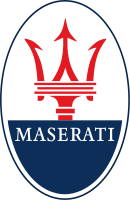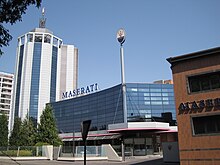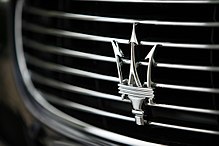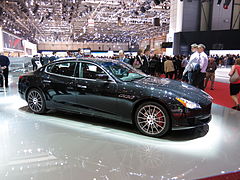Maserati
| Maserati SpA
|
|
|---|---|
| legal form | Società per azioni |
| founding | 1914 (as Officine Alfieri Maserati ) |
| Seat |
Modena , Italy |
| management | |
| sales | EUR 4.06 billion (2017) |
| Branch | Automotive industry |
| Website | www.maserati.com |

Maserati is an Italian automobile manufacturer based in Modena . The company was founded in Bologna in 1914 . The trademark is a trident .
In the 1950s Maserati racing cars were successful, including won Juan Manuel Fangio in a 250F the Formula 1 World Championship 1957 . Maserati is traditionally in a competitive relationship with Ferrari , but was run from 1997 to 2005 as a subsidiary of Ferrari within the Fiat Chrysler group.
history
family business
The Società Anonima Officine Alfieri Maserati (SA Officine Alfieri Maserati), founded in Bologna on December 1, 1914, was a family business. Alfieri Maserati was the founder . Three of his five brothers later joined the company.
Carlo (1881–1910), Bindo (1883–1980), Alfieri (1887–1932), Mario (1890–1981), Ettore (1894–1990) and Ernesto Maserati (1898–1975) were born in the Lombard town of Voghera . The parents of the siblings known as Fratelli Maserati (Maserati brothers) were Rudolfo and Carolina Maserati. Her father worked as a railway engineer. With the exception of Mario Maserati, who worked as a painter, all of the Maserati brothers developed technical affinities.
Carlo Maserati built his first motorcycle in 1898, with which he repeatedly competed. At the beginning of the 20th century he became a test and racing driver for Fiat and worked for a time with Vincenzo Lancia . In 1903 he moved to Isotta Fraschini , in 1907 to Bianchi and in 1909 to Junior . Carlo Maserati died in 1910 of complications from tuberculosis .
Alfieri and Bindo Maserati followed their brother Carlo to Isotta Fraschini in 1903. In 1910 they went to Argentina on behalf of the Milan-based car manufacturer to work in the Isotta branch there. Alfieri constructed a racing car with Isotta technology in Buenos Aires , which he used himself in automobile competitions, but the Maserati brothers returned to Italy as early as 1914.
On December 1, 1914, Alfieri Maserati founded his own company in Bologna, where Isotta Fraschini's customer cars were to be prepared for racing. When Italy entered the First World War , the workshop's activities largely came to a standstill. Alfieri Maserati developed spark plugs during this time, while his brother Ernesto, who had also initially worked for Alfieri, designed aircraft engines for Franco Tosi during the war .
Beginnings in racing
After the end of the war, Alfieri, Ernesto and Ettore Maserati started working again. On behalf of Isotta Fraschini and from 1922 for Diatto, they designed a number of racing cars that achieved individual successes in Grand Prix races. When Diatto retired from automobile racing in 1925, the Maserati brothers took over the design. This project resulted in the Maserati Tipo 26 , the first racing car to carry the Maserati brand name. In April 1926, the car driven by Alfieri Maserati achieved the company's first class win at the Targa Florio in the 1.5-liter class. After initially only sporadic races, Maserati took part regularly in motor racing events from 1929 onwards. The company had a factory team, but also sold its vehicles to independent customers. With the introduction of the Maserati Tipo 6CM in 1936, there was continued success; Maserati had won a total of 19 races by the outbreak of World War II .
The Orsi era: racing successes and the first street sports cars
In 1932, Alfieri Maserati died at the age of 44 from the long-term effects of a racing accident. In the following years, Bindo Maserati, who had previously worked at Isotta Fraschini, took over the management of the Officine Alfieri Maserati, while Ettore was responsible for development and administration.
Regardless of the racing success, the company no longer developed the dynamism that it had had during Alfieri Maserati's lifetime. In 1937, the remaining Maserati brothers sold the company to the Modena-born industrialist Adolfo Orsi , who operated several steelworks in his hometown and manufactured agricultural machines and machine tools. Orsi wanted to use Maserati's racing successes primarily for advertising purposes for his other companies. Until the post-war period, the name Maserati appeared not only on automobiles, but also on technical devices produced by the Orsi Group. Maserati also manufactured motorcycles during this time. The Maserati brothers Bindo, Ernesto and Ettore stayed for ten years as consultants in the company, whose headquarters were relocated to Modena in the early 1940s. In 1947 they separated from Maserati and founded a rival company with Officine Specializzata Costruzioni Automobili (OSCA) in Bologna.
After the end of the Second World War, the Orsi Group faced economic and political difficulties. This included numerous, sometimes violent, strikes by the workforce, in which the Maserati plant was temporarily closed. In 1950 the group was restructured, which led to the separation of Maserati. In future, Adolfo Orsi, together with his son Omar, was only responsible for managing the racing car manufacturer, while the other operations in the group were managed by Orsi's siblings.
After the turbulence of the early post-war period had subsided, Maserati became a fixture in automobile racing in the 1950s. This process was facilitated by the withdrawal of the previously dominant Alfa Romeo team. The 1953 Maserati 250F was one of the most popular Formula 1 cars of its generation; until 1960 he took part in 46 world championship races and numerous Formula 1 races without world championship status. Maserati had a regular factory team in those years; in addition, numerous private drivers reported Maserati designs. In 1957 won Juan Manuel Fangio with the Maserati factory team riders World Cup; it was Fangio's fifth world title. 1958 Maserati withdrew from Formula 1 for financial reasons; However, customer vehicles were still in use until 1960, and Maserati engines were to be found in Cooper's Formula 1 cars until the late 1960s . After a few years without motorsport involvement, Maserati was again successful in sports car races in the early 1960s with cars like the Tipo 61 ("Birdcage") .
Not least for economic reasons, Maserati made the switch from a pure racing car manufacturer to a manufacturer of street sports cars in the 1950s: Similar to Scuderia Ferrari , Maserati was also dependent on additional income in order to successfully maintain racing operations. This income could only be achieved through the sale of street sports cars. While Maserati's first production model, the A6 , was only produced in double-digit numbers, its successor 3500 GT with a standardized touring body was produced almost 2,000 times. Maserati's managing director Omer Orsi consistently expanded the product range in the following years. In the field of super sports cars, the 5000 GT was created , one of the purposes of which was to recycle unused racing car components. On the other hand, the Quattroporte I from 1963 also established Maserati in the sports sedan segment. In the early 1960s, Maserati became a serious competitor for Ferrari. Maserati temporarily reached its production figures; Lamborghini , added as a further competitor in 1963, was usually even surpassed. The chassis technology of the traditional Maserati was not very complex at this time - the rear leaf springs installed in some of the brand's sports cars until 1975 made the cars appear "very fast trucks" in the eyes of the press -; in terms of style and appearance, however, they were at least equivalent to Ferrari.
With the Mistral introduced in 1963 , the company established the tradition of naming its street sports cars after the winds of the Mediterranean. It was followed by many, but not all, later models. This was the case for the Ghibli , which many observers consider to be one of the most beautiful sports cars ever produced, the Bora and the Khamsin and, in later years, for the Karif and Shamal .
Citroën: mid-engine sports car and ambitious technology
At the end of the 1960s, Maserati ran into economic difficulties that the Orsi Group was no longer able to absorb. In 1968 the French high-volume manufacturer Citroën took over 60 percent of the company's shares. Giulio Alfieri remained Maserati's chief designer. He gradually modernized the company's model range and, following the instructions of the new owner, repeatedly resorted to Citroën designs. This particularly affected the ambitious hydraulics that Maserati's new models of steering and braking took over. The Citroën era also saw the introduction of the Merak and Bora mid-engined sports cars , which implemented a new technical concept for Maserati. The cars, also designed by Alfieri, were to be produced in larger numbers and to open up new groups of buyers. Accordingly, the comparatively inexpensive Merak with a six-cylinder engine was positioned as a competitor to the Porsche 911 . The Merak's six-cylinder engine was also used in the Citroën SM .
However, Citroën's plans could not be implemented. Neither the Merak nor the Bora achieved the expected numbers. In addition, the introduction of a Quattroporte successor with Citroën technology failed at the development stage. Finally, sales of the traditional sports cars that were still being produced with fuel -intensive eight-cylinder engines fell sharply in view of the oil crisis in the mid-1970s. In 1974 alone, Maserati's losses amounted to US $ 5 million. Ultimately, Citroën itself got into economic difficulties and was taken over by its previous competitor Peugeot . As a result of these developments, Maserati was insolvent in 1975 and - like its competitors Iso , Aston Martin and Monteverdi - faced closure.
De Tomaso: Large-scale manufacturer with biturbo technology
In order to avert the closure of Maserati, the company's employees formed a defense committee in 1975 and occupied the factory buildings. On the instructions of the Italian government, the state holding company GEPI took over the Maserati shares from Citroën. At this time, takeover negotiations began with the entrepreneur Alejandro de Tomaso , who in turn manufactured sports cars under the De Tomaso brand. De Tomaso finally bought Maserati in August for 300,000 lire - the equivalent of about 155 euros (as of 1998) - and received permission from the Italian government to reduce the workforce by 50%. The long-time chief engineer Giulio Alfieri, who moved to Lamborghini, was one of the employees who left the company. Alejandro de Tomaso became president of the company; The management was temporarily taken over by the economist and later politician Romano Prodi .
Alejandro De Tomaso initially continued the production of the well-known sports cars, but added two vehicles based on De Tomaso technology to the model range with the Kyalami and the Quattroporte III . In the medium term, he aimed to realign the company, which was implemented in 1981. With the compact biturbo , Maserati was to go from a small to a large series manufacturer. The Biturbo family determined the image of the company for the next 15 years. Under the direction of Alejandro De Tomasos, new body versions were constantly being created, including coupés with three different wheelbases, a convertible and a four-door sedan. Numerous versions were also created in the engine area: there were engines with 2.0 l, later also 2.5 l and 2.8 l units for export, initially with three-valve technology, later with four valves per unit Cylinder. Finally, an eight-cylinder engine with 3.2 liters displacement was also designed, the model names were confusing: Biturbo Si, 222, 228, 425, 430, 422, 2.24 v, 4.24 v, plus the Biturbo Spyder, Karif and the Racing model . The last newly introduced model based on the biturbo structure was the Quattroporte IV , which was sold until 2001.
The Biturbo family initially suffered from significant quality defects in the engine and bodywork areas, which were, however, gradually rectified. Overall, it ensured the survival of Maserati and the other companies belonging to the De Tomaso Group into the 1990s.
The introduction of the Biturbo family led to a significant increase in production at Maserati. From 498 vehicles in 1981, emissions quadrupled in the first full biturbo year in 1982 to 2,265 units. In 1983 almost 5,400 Maseratis were built, and in 1984 even 6,300. Then the quality defects and the associated damage to the reputation became noticeable. The production figures settled in the second half of the 1980s between 2000 and 3000 copies per year, 1991 and 1992 only a little more than 1000 cars were sold. From 1984 Maserati made no more profit with the biturbo; In addition, there were high costs from warranty services, which were mainly due to engine defects. Alejandro de Tomaso initially won the US high-volume manufacturer Chrysler as an investor, with whose CEO Lee Iacocca he had already worked 15 years earlier at Ford. This connection resulted in the Chrysler TC by Maserati , which was largely manufactured in Italy. However, the car could not meet expectations, so that Chrysler withdrew after a few years. De Tomaso then transferred 49 percent of the Maserati shares to Fiat in the fall of 1989. In return, Fiat granted Maserati “generous bank loans” to prevent Mazda's feared entry into De Tomaso.
In 1991 Maserati reappeared in motorsport: the company developed the homologation model Barchetta , the street version of which the Barchetta Stradale was never built in series. Nevertheless, there are a few approved Barchettas - all of them converted racing versions. A Barchetta got the 2.8-liter V6 engine, while the originals raced with a 2.0-liter machine.
Fiat: repositioning with Ferrari help
In May 1993, Fiat acquired the remaining Maserati shares. Alejandro de Tomaso had previously suffered a stroke and was no longer able to take care of the company in the usual way. De Tomaso used the proceeds to finance the development of the Guarà , the last sports car of his own brand. At Maserati, Eugenio Alzati became Managing Director. Under his leadership, the new Ghibli and Quattroporte IV were created based on the biturbo engine series.
On July 7, 1997, Fiat Maserati reported to Ferrari . Ferrari initially acquired 50% in order to take over Maserati completely the following year. In the summer of 1997, Ferrari temporarily stopped production of the Quattroporte IV. In the months that followed, Ferrari renovated Maserati's outdated manufacturing facilities with the aim of improving build quality and efficiency. During this time, the Quattroporte IV was extensively revised. The second series of the sedan was available from May 1998. At the same time, the new Maserati 3200 GT appeared , a coupé with a body by Giorgetto Giugiaro , which only had references to the Biturbo family in the engine area, but was otherwise completely redesigned. The 3200 GT and its successor, known only as the Maserati Coupé, together with the convertibles derived from it, shaped the image of the brand until 2007.
In 2004 Maserati returned to motorsport after a hiatus of 37 years. This year the company presented the MC12 GT1 , which was a further development of the Ferrari Enzo and should compete in the FIA GT championship . 25 street versions derived from it named MC12 were given to “loyal customers” of the brand.
In 2005, the Fiat Holding Maserati separated from the Ferrari-Maserati-Group and runs it as an independent stock corporation analogous to Ferrari. The close cooperation between Maserati and Ferrari continued.
Production vehicles from Maserati
Five models are currently available:
- Maserati GranTurismo (since 2007)
- Maserati GranCabrio (since 2010)
- Maserati Ghibli III (since 2013)
- Maserati Quattroporte VI (since 2013)
- Maserati Levante (since 2016)
In autumn 2007, the Maserati GranTurismo with a 4.2-liter engine and in 2008 the more powerful GranTurismo S with a 4.7-liter engine appeared. This has also been offered as the GranTurismo S Automatic since 2009 .
The Maserati GranCabrio - a four-seater convertible with an elegant fabric top based on the GranTurismo S Automatic - had its world premiere at the 2009 Frankfurt Motor Show . Production at the Maserati plant on Viale Ciro Menotti in Modena has been running since the beginning of 2010; the first convertibles were delivered in May 2010.
The study of the SUV model Maserati Kubang was presented at the IAA in Frankfurt 2011 . It was based on a Jeep platform and was originally scheduled to hit the market in 2013. Over time, the study was continuously developed and finally presented for series production under the final name Maserati Levante .
Maserati in automobile racing
Maserati's roots are in automobile racing. Even before the Maserati brothers founded their own company, they had designed racing cars with Isotta-Fraschini technology and used them in competitions. It was only four decades after the company was founded that Maserati began producing road vehicles.
Victories in the sports car world championship
| year | run | vehicle | Driver 1 | Driver 2 |
|---|---|---|---|---|
| 1956 | 1000 km race of Buenos Aires | Maserati 300S |
|
|
| 1000 km race at the Nürburgring | Maserati 300S |
|
|
|
| 1957 | Sebring 12 hour race | Maserati 450S |
|
|
| Kristianstad 1000 km race | Maserati 450S |
|
|
Maseratis motorcycles
In 1947 Adolfo Orsi founded the legally independent company Fabbrica Candele Accumulatori Maserati SpA , which structurally had nothing to do with the racing car manufacturer Maserati, but used its name. The company, headed by Adolfo Orsi's sister Ida from 1949, was based in Modena. In 1953 Orsi bought the small Bolognese motorcycle manufacturer Italmoto , which produced small single-cylinder two- and four-stroke machines. Italmoto's designs had a reputation for superior quality and were selling well. Orsi moved the company to Modena and marketed the motorcycles from 1953 to 1960 under the name Maserati. Initially the sales figures remained at the level of Italmoto; but soon the Maserati motorcycles showed considerable quality defects; Due to manufacturing defects, piston jams often occurred. The reputation of Maserati's motorcycles suffered as a result, so that sales on the Italian market soon collapsed. For a while the motorcycles were still sold in South Africa and South America; At the end of the 1950s, however, Orsi stopped production.
literature
- Georg Amtmann, Halwart Schrader : Italian sports cars. Motorbuch-Verlag, Stuttgart 1999, ISBN 3-613-01988-4 .
- Matthias Braun, Alexander Franc Storz: Maserati type compass. Passenger car since 1947 . Motorbuch Verlag, Stuttgart 2007, ISBN 978-3-613-02708-4 .
- Martin Buckley: Maserati. Italian luxury and flair . Heel Verlag, Königswinter 2012. ISBN 978-3-86852-633-2 .
- Richard Crump, Robert de LaRive Box: Maserati: sports, racing and GT cars; 1926-1991 . Serag-AG, Pfäffikon (CH) 1998, ISBN 3-908007-79-8 .
- Wolfgang Hörner: Maserati Retrospective: All series vehicles in original documents . Wieland, Bruckmühl 2004, ISBN 3-9808709-5-2 .
- Hans-Karl Lange: Maserati. The other Italian sports car. Zsolnay, Vienna 1993, ISBN 3-552-05102-3 .
- Jürgen Lewandowski: Maserati . 1st edition. Motorbuch-Verlag, Stuttgart, 2008. ISBN 978-3-613-02934-7 .
- Karl Ludvigsen: Ferrari versus Maserati - relentless motorsport rivals . Rybiczka, Dorko M. [translation]. Heel, Königswinter 2008, ISBN 978-3-86852-051-4 . Uniform title Red-hot rivals.
- David Sparrow, Iain Ayre: Maserati Heritage . Osprey Classic Marques. Auckland 1995. ISBN 1-85532-441-5 .
- Maurizio Tabucchi, Luciano Greggio, Dorko M. Rybiczka (ex.): Maserati: All Grand Prix, Sports & GT vehicles from 1926 to today . Heel, Königswinter 2004, ISBN 3-89880-211-6 .
Web links
Individual evidence
- ^ Maserati.com - Company
- ↑ fcagroup.com -Annual Report 2017 , p. 69
- ↑ Alfieri Maserati, born in 1887, was the second child of his parents to bear this name. The first Alfieri Maserati was born in 1885 and died the following year.
- ^ A b c Martin Buckley: Maserati. Italian luxury and flair . Heel Verlag, Königswinter 2012. ISBN 978-3-86852-633-2 , p. 7.
- ↑ a b c Mike Lawrence: Grand Prix Cars 1945-1965 , Motor Racing Publications 1998, ISBN 1-899870-39-3 , p. 201.
- ↑ a b Hans-Karl Lange: Maserati. The other Italian sports car. Zsolnay, Vienna 1993, ISBN 3-552-05102-3 , p. 4.
- ^ Jill C. Wheeler: Maserati . ABDO Publishing Company, 2010, ISBN 978-1-61786-167-3 , p. 8.
- ^ A b c Martin Buckley: Maserati. Italian luxury and flair . Heel Verlag, Königswinter 2012. ISBN 978-3-86852-633-2 , p. 10.
- ↑ Hans-Karl Lange: Maserati. The other Italian sports car. Zsolnay, Vienna 1993, ISBN 3-552-05102-3 , p. 6.
- ^ Martin Buckley: Maserati. Italian luxury and flair . Heel Verlag, Königswinter 2012. ISBN 978-3-86852-633-2 , p. 11.
- ↑ Hans-Karl Lange: Maserati. The other Italian sports car. Zsolnay, Vienna 1993, ISBN 3-552-05102-3 , p. 7.
- ^ Martin Buckley: Maserati. Italian luxury and flair . Heel Verlag, Königswinter 2012. ISBN 978-3-86852-633-2 , p. 13.
- ↑ Exceptions were the Maserati Mexico, the Maserati Indy and the Maserati Quattroporte.
- ↑ Bernd Woytal: Maserati Ghibli 4.9 SS: Donnerbolzen. In: Bernd Wieland: Italian classic sports cars . 1st edition. Stuttgart (Motorbuch Verlag) 2001, p. 119.
- ^ A b Martin Buckley: Maserati. Italian luxury and flair . Heel Verlag, Königswinter 2012. ISBN 978-3-86852-633-2 , p. 118.
- ↑ Hans-Karl Lange: Maserati. The other Italian sports car. Zsolnay, Vienna 1993, ISBN 3-552-05102-3 , p. 53.
- ↑ Wolfgang Blaube: Better knowledge with Wolfgang Blaube: Romano Prodi was Maserati boss . Oldtimer Markt, issue 11/2015, p. 22.
- ↑ a b Hans-Karl Lange: Maserati. The other Italian sports car. Zsolnay, Vienna 1993, ISBN 3-552-05102-3 , p. 78 f.
- ↑ a b c d e Georg Amtmann, Halwart Schrader: Italian sports cars. Motorbuch-Verlag, Stuttgart 1999, ISBN 3-613-01988-4 , p. 309.
- ^ Georg Amtmann, Halwart Schrader : Italian sports cars. Motorbuch-Verlag, Stuttgart 1999, ISBN 3-613-01988-4 , p. 308.
- ↑ Auto Catalog No. 42 (1998/99), p. 99.
- ↑ Successes in the sports car world championship in 1956 ( Memento from June 24, 2003 in the web archive archive.today )
- ↑ Successes in the sports car world championship in 1957 ( Memento from June 24, 2003 in the web archive archive.today )
- ^ Martin Buckley: Maserati. Italian luxury and flair . Heel Verlag, Königswinter 2012. ISBN 978-3-86852-633-2 , p. 8.



















